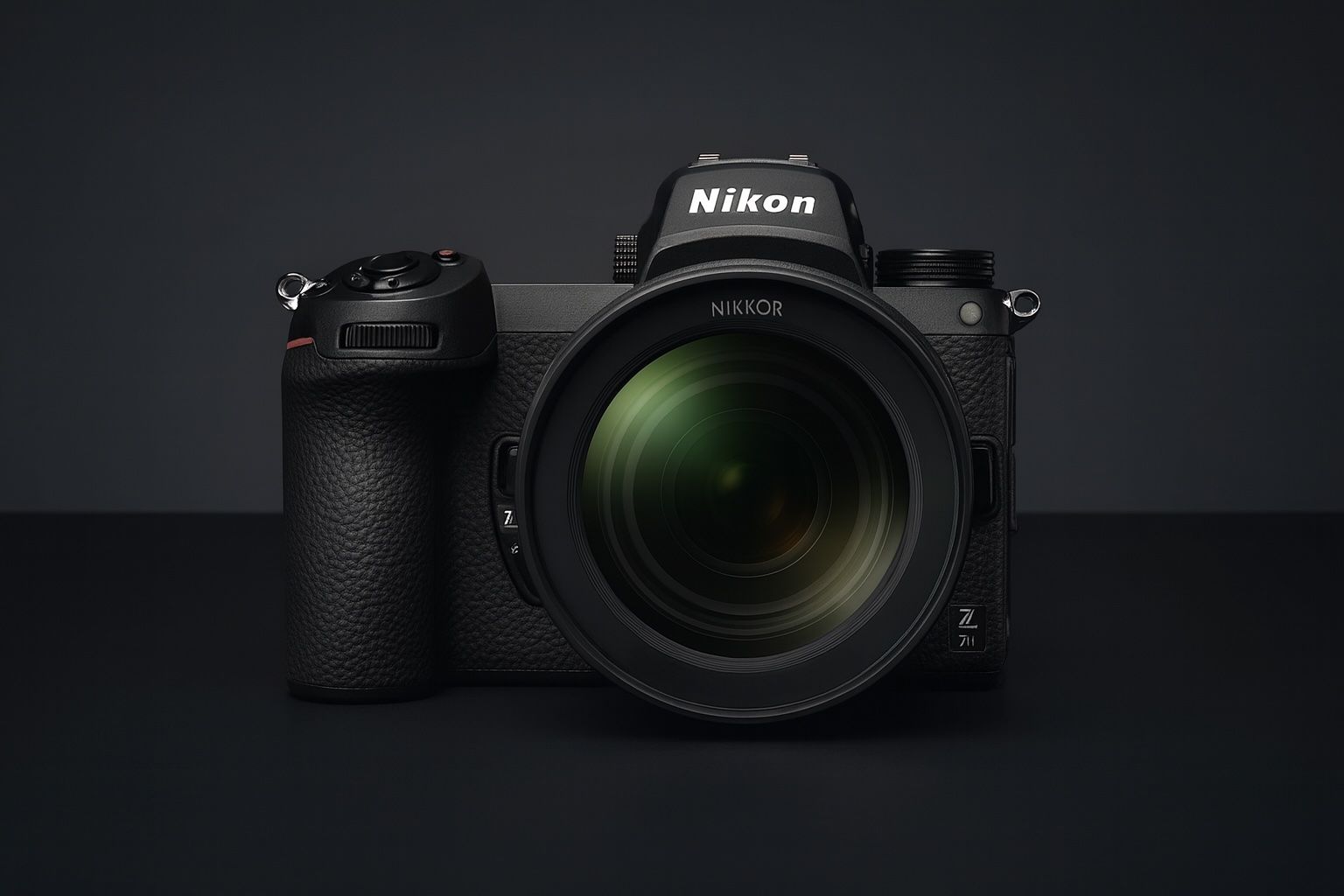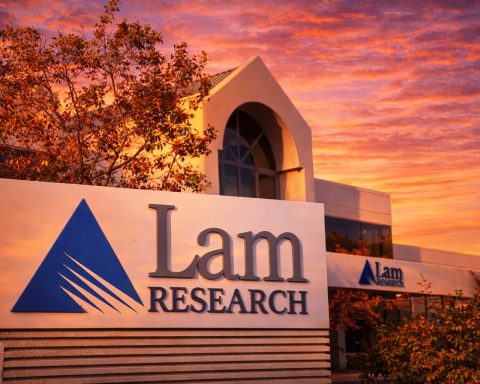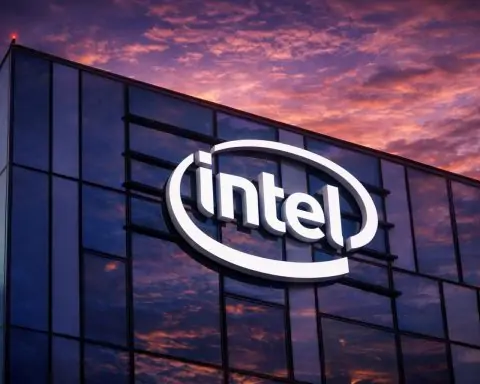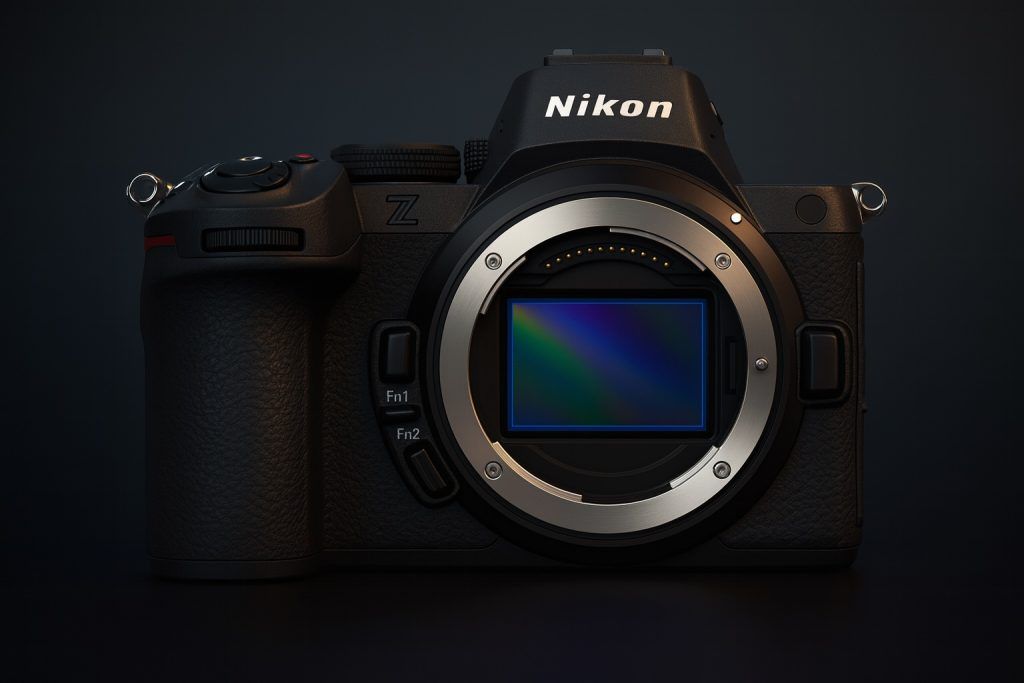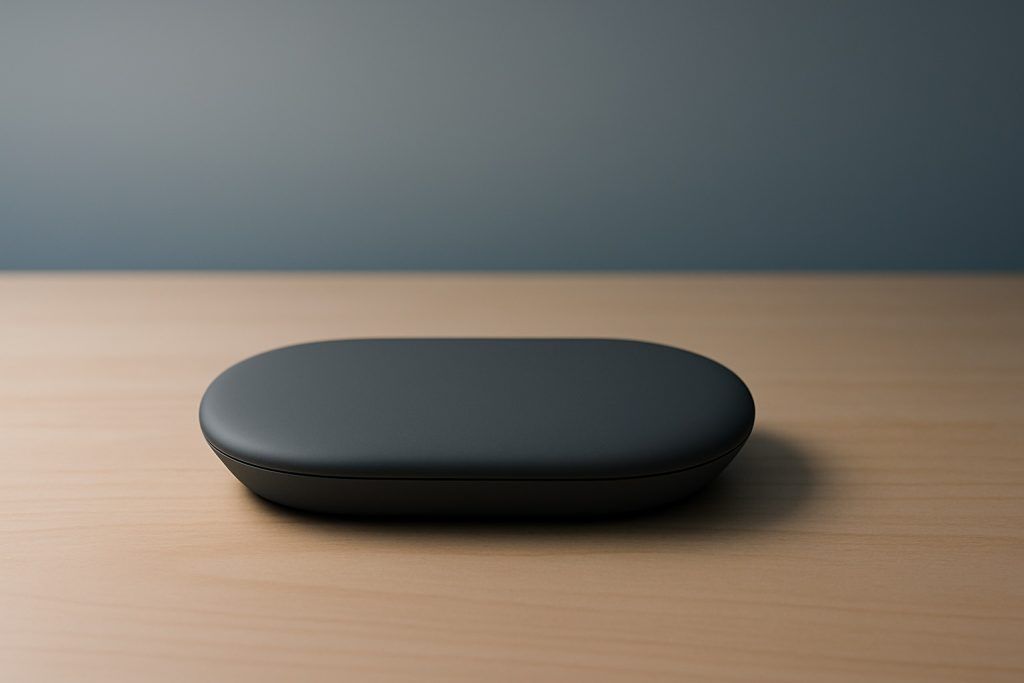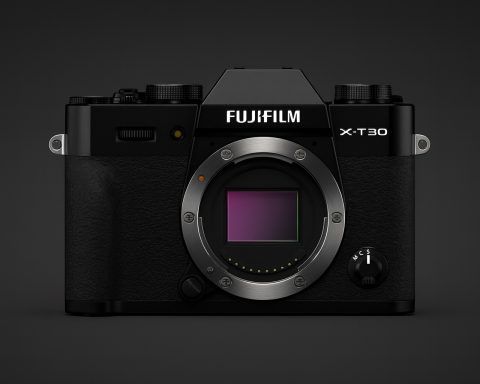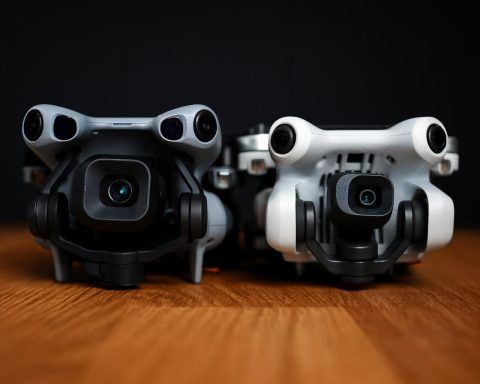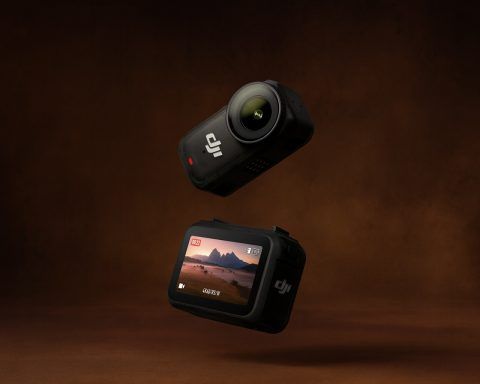Key Facts – Nikon Z7 II vs Major Competitors
| Camera | Sensor & Resolution | Continuous Shooting | Max Video | Autofocus System | Stabilization (IBIS) | Card Slots | Battery Life (CIPA) | Launch Price (USD) |
|---|---|---|---|---|---|---|---|---|
| Nikon Z7 II (2020) | 45.7 MP BSI CMOS, full-frame (base ISO 64) [1] [2] | Up to 10 fps (RAW burst ~77 frames) [3] | 4K up to 60p (1.08× crop) [4]; 1080p 120p | 493-point on-sensor PDAF; Human/animal Eye-Detect [5] | 5-axis in-body (≈5 stops; ISO 64 improves IQ) [6] [7] | 1× CFexpress/XQD + 1× SD UHS-II [8] | ~440 shots (LCD) / 380 (EVF) [9] | $2,999 (body) [10] |
| Sony A7R V (2022) | 61.0 MP BSI CMOS, full-frame (ISO 100 base) [11] | Up to 10 fps (JPEG/RAW, with large buffer) [12] | 8K up to 24p; 4K up to 60p (full width) [13] [14] | 693-point PDAF; AI-based subject recognition (Real-time Eye AF) [15] | 5-axis in-body, up to 8.0 stops [16] | 2× SD UHS-II (dual CFexpress Type-A compatible) [17] | ~530 shots (LCD) / 440 (EVF) [18] | $3,899 (body) [19] |
| Canon EOS R5 (2020) | 45.0 MP CMOS, full-frame (ISO 100 base) [20] | 12 fps mechanical / 20 fps electronic [21] | 8K up to 30p (RAW or H.265) [22]; 4K up to 120p | Dual Pixel CMOS AF II (1053 points, 100% coverage; people/animal detect) [23] | 5-axis in-body, up to 8 stops (with lens IS) [24] | 1× CFexpress Type-B + 1× SD UHS-II [25] | ~490 shots (LCD) / 320 (EVF) [26] | $3,899 (body) [27] |
| Panasonic Lumix S1R (2019) | 47.3 MP CMOS, full-frame (ISO 100 base) [28] | 9 fps (AF-S) / 6 fps (AF-C) [29] | 4K up to 60p (8-bit 4:2:0, APS-C crop) [30]; 4K30p full-width | DfD Contrast AF (225 areas), face/eye detect | 5-axis in-body, ~6.0 stops (Dual I.S. up to 6.5 stops with OIS lens) [31] | 1× XQD/CFexpress Type-B + 1× SD UHS-II [32] | ~360 shots per charge [33] | $3,699 (body) [34] |
Note: Newer models like the Nikon Z8, Canon EOS R5 Mark II, Sony a1 II, and Panasonic S1R II have since launched with improved specs – these will be discussed later in the report.
Image Quality and Sensor Performance
The Nikon Z7 II delivers superb image quality for stills – its 45.7MP sensor offers excellent detail, dynamic range, and low-light performance. In fact, DxOMark tests gave the Z7 II sensor a score of 100, placing it jointly at the top of full-frame rankings alongside Nikon’s D850 and rivals like the Sony a7R III and Panasonic S1R [35] [36]. Reviewers laud the Z7 II’s base ISO 64 setting, which yields class-leading dynamic range (~14.7 EV) and rich color depth [37]. This means landscape photographers can capture extra highlight and shadow detail – one expert even calls it “one of the best cameras on the market for landscape photography,” partly because of that ISO 64 dynamic range advantage [38].
By comparison, the Sony A7R V pushes resolution further with 61MP. Its image quality is likewise outstanding, with a base ISO of 100 and dynamic range nearly on par with the Nikon. However, the Sony’s higher pixel count can show a bit more noise at pixel level in low light. The Canon EOS R5’s 45MP sensor is similar in resolution to the Z7 II. Canon’s files are known for great colors, though some reviewers note Canon applies a bit of built-in noise reduction to R5 RAW files, which trades a hint of fine detail for cleaner output [39]. In practice, all of these high-resolution sensors produce stunning images; differences emerge in extreme pushing of shadows or when using each camera’s base ISO: at ISO 64 the Nikon has the edge in terms of image quality and dynamic range over ISO-100-bound competitors [40].
The 47MP Panasonic S1R, though a year older, also offers fantastic detail and dynamic range (it tied the Z7 II’s sensor score in DxO’s rankings) [41]. Its images are extremely sharp and richly detailed [42]. But the S1R’s older sensor design (non-BSI) and lack of dual gain ISO mean its high-ISO noise is a bit worse. All four cameras can produce large prints or allow tight cropping thanks to their high megapixel counts. And for even more resolution, some offer multi-shot modes: the Sony A7R V’s Pixel Shift can combine images into ~240MP files, and the Panasonic S1R’s tripod high-res mode produces 187MP images with incredible detail (even correcting for small motion) [43]. Nikon doesn’t (yet) offer a pixel-shift mode on the Z7 II, relying on its native 45MP – but those pixels are of very high quality.
Overall, Nikon’s Z7 II holds its own or beats its peers in pure image quality, especially at base ISO. As PetaPixel summarizes, “the image quality is still great” on the Z7 II, and it can “rival some medium format systems” in dynamic range and color for a fraction of the cost [44]. Its RAW files have tremendous flexibility for editing. The Z7 II also produces very clean JPEGs with Nikon’s pleasing color science (though some find Nikon’s default noise reduction a bit heavy). Meanwhile, Sony’s extra resolution gives it a slight advantage for gigantic prints or cropping, whereas Canon’s strength is fast in-camera processing and gorgeous color straight-out-of-camera (at the expense of aggressive noise reduction by default) [45].
In summary: All these cameras are excellent for image quality. The Z7 II particularly shines for dynamic range (especially at ISO 64) and base ISO clarity [46] [47]. The Sony A7R V wins on sheer resolution. The Canon R5 offers a well-rounded image output with arguably the best balance of resolution and speed, though with slightly lower DR at base ISO. And the Panasonic S1R delivers beautiful images but lags in high-ISO noise and is now surpassed by its successor (the S1R II with a new 44MP BSI sensor). If ultimate image quality is your goal, each camera has a slight twist: Nikon for maximum dynamic range, Sony for maximum pixels, Canon for rich color and 8K detail (more on that next), and Panasonic for those who value Leica/Zeiss lens options and ultra-high-res multi-shot modes.
Autofocus Performance and Speed
Autofocus is an area where the competitors differentiate themselves more clearly. Nikon improved the Z7 II’s AF over the first-gen Z7, adding Eye-Detection for humans and animals and refining tracking algorithms [48] [49]. In real use, the Z7 II’s 493-point hybrid AF is fast and accurate for static subjects, and Eye AF works well for people and pets in most situations [50] [51]. However, both lab tests and field reviews note that Nikon’s system isn’t quite on par with the very best from Sony and Canon for tracking moving subjects [52] [53]. DPReview found the Z7 II’s subject tracking occasionally loses the precise focus point on a subject, and the Eye AF can front-focus by a tiny fraction at times [54] [55]. The Z7 II can shoot at up to 10 frames per second – a respectable burst rate for a high-resolution camera – but its autofocus can struggle to keep up with fast action (e.g. erratic sports or wildlife) compared to sports-oriented models [56] [57]. In Nikon’s own lineup, the Z7 II is geared more to landscape, studio, and portrait shooters (which it handles very well), not as much to high-speed action [58].
By contrast, Sony’s AF systems have been class-leading, and the A7R V inherits that legacy. It has 693 phase-detect points covering most of the frame [59] and Sony’s latest Real-time Tracking AF augmented by an AI chip dedicated to subject recognition. This means the A7R V can lock onto and follow eyes, faces, and even animals or vehicles with uncanny tenacity. Reviewers report Sony’s Eye AF is extremely “sticky” and reliable, requiring little user intervention. In challenging action scenarios, the A7R V will generally outperform the Z7 II in hit rate, despite both cameras offering similar 10 fps burst speeds [60]. The downside is that the Sony’s autofocus menu system, while improved, can still be complex – but once set, it just works. DPReview’s comparison noted the a7R IV/V’s autofocus was quicker and easier to use, offering greater precision than the Nikon, especially for moving subjects [61].
The Canon EOS R5 is often praised for its autofocus as well. Canon’s Dual Pixel CMOS AF II covers the entire frame with 1053 automatic points [62]. It intelligently tracks eyes, faces, and animals (even birds in flight) using deep learning. The R5’s AF is fast and effortless; many photographers love that you can simply tap the screen or half-press and the camera finds the subject’s eye almost instantly. Importantly, Canon’s AF interface is very simple – you don’t have to juggle between eye-detect and tracking modes as much as on Nikon [63]. Canon allows you to just enable Eye AF and use “Servo AF” for continuous tracking, and the system decides whether to track a face or general subject. In terms of speed, the R5 has an edge with up to 12 fps with the mechanical shutter (and 20 fps electronic) while maintaining AF-C – meaning it can capture fast action better if needed [64]. In practice, the R5’s subject tracking is on par with Sony’s in many situations, and clearly above the Z7 II’s. DPReview concluded the R5’s AF performance is a little better and simpler than the Z7 II’s, which is one reason the R5 commands a higher price [65].
The Panasonic S1R, unfortunately, is a step behind in AF. It uses a Contrast-detect system with Panasonic’s DfD (Depth-from-Defocus) technology, which lacks phase-detect pixels on the sensor. While fine for static scenes (and very accurate in single-shot mode), the S1R’s continuous AF can struggle with fast-moving subjects and tends to “wobble” or flutter as it refocuses [66]. Panasonic owners often note that for action or birds, the S1R is not ideal. The newer Panasonic S1R II (released 2024) finally adds phase-detect AF, greatly improving Panasonic’s tracking performance – but the original S1R lags behind Nikon, Canon, and Sony for AF. On the S1R, you can still capture action at 6–9 fps, but the keeper rate will be lower because the focus might not lock consistently on a moving eye/subject.
To sum up AF: Sony and Canon lead the pack in autofocus sophistication and reliability for both humans and wildlife. Nikon’s Z7 II, while very good (and vastly better than DSLRs in covering the frame), is just a notch below – reviewers note that its tracking isn’t as “set-and-forget” as Canon’s or Sony’s, especially if your subjects and composition change quickly [67] [68]. Indeed, the Z7 II requires the photographer to switch AF area modes (Auto-area, Wide, Tracking, etc.) more often, whereas Canon/Sony can seamlessly track from spot AF to face eye-detect in one mode [69] [70]. Nikon has been addressing this in newer models (the flagship Z9 and recent Z8 have much improved AF tracking). Speed-wise, the R5’s 20 fps e-shutter and the Sony’s confident tracking give those cameras an edge for sports/wildlife bursts. The Z7 II’s 10 fps is decent but not class-leading, and its smaller buffer (~3 seconds of RAW burst) means it’s not built for long high-speed sequences [71] [72]. Still, for portrait, landscape, and moderate action, the Z7 II’s AF is “more than good enough” – it nailed focus in challenging low-light portrait tests and even held its own in some sports bursts during reviews [73] [74]. Just know that for demanding action shooters, newer models like Nikon’s own Z8/Z9 or Sony’s A1/A9 series are better suited.
(On a positive note, Nikon has steadily improved AF via firmware too – eye-detect in video and wider subject recognition were added to the Z7 II over time [75] [76]. But the fundamental hardware limits (older processor, no stacked sensor) mean it can’t match the cutting-edge AF of its 2021–2023 rivals.)
Video Capabilities and Features
When it launched, the Nikon Z7 II was not primarily aimed at video shooters, but it still offers fairly robust video specs for a high-res camera. It can record up to 4K at 60p, albeit with a mild ~1.1× crop of the frame [77]. At 4K 30p and below, it uses the full sensor width (oversampling from 6K down to 4K in 30p mode). The image quality in 4K is quite good – footage is detailed and clean at lower ISOs, though not as tack-sharp as some competitors that do heavier oversampling or 8K capture [78] [79]. Because the Z7 II’s 45MP sensor has more pixels than needed for 4K, it line-skips to read video, rather than doing a full downsample. This can introduce a bit more moiré and noise than an oversampled readout [80]. DPReview noted that the Z7 II’s 4K output, especially at 60p, is slightly softer and less detailed than the Sony a7R IV’s comparable mode [81]. That said, it’s still impressive that the Z7 II can do 4K/60 at all – the original Z7 could only do 4K/30. The small crop at 60p is actually an advantage in some cases, as Nikon pointed out: you can get 60p without a heavy APS-C crop, preserving more field of view [82]. In DX (APS-C) mode, the Z7 II can even produce slightly crisper 4K (since it then reads a 5.5K region without line-skipping) [83], though at the cost of a tighter frame and higher noise (using only part of the sensor).
One highlight for advanced videographers is that Nikon offers RAW video output on the Z7 II. With an optional paid firmware upgrade and an external recorder, the Z7 II can output ProRes RAW or Blackmagic RAW video at up to 4K/30p via HDMI [84]. This gives a ton of flexibility in post-production (adjusting white balance and ISO after the fact). It’s a niche feature, but one that signals Nikon’s commitment to serious video users. The camera also supports 10-bit 4:2:2 recording (with N-Log or HLG HDR profile) externally – internally it’s limited to 8-bit 4:2:0 for regular recordings [85]. This was a bit of a letdown to some, since competitors like Panasonic offered internal 10-bit. Nonetheless, for most users, the Z7 II’s internal footage in 8-bit is fine and can be graded if shot in a flat profile.
Now, looking at the competition: Canon’s EOS R5 garnered massive attention as the first consumer camera with 8K. It can shoot 8K UHD or DCI up to 30 fps using the full sensor, even in RAW video format [86]. It also delivers beautiful oversampled 4K – essentially, the R5 can downsample 8K to a super-detailed 4K (Canon calls this 4K “HQ” mode) at up to 30p, and also do 4K/60 and even 4K/120 (the latter with slight quality loss). The caveat with the R5 (at least the original model) was overheating. All that 8K horsepower in a small body meant that recording times were limited – roughly 20 minutes of 8K or 4K HQ before the camera might overheat and force a cooldown. This was a big topic in 2020 [87]. Firmware updates improved it slightly, but R5 users still have to manage heat for long video shoots. As DPReview put it, the R5 “can capture truly excellent-looking 8K and 4K,” but “it’s not able to shoot its best video for extended periods…making it less dependable than you’d hope” for heavy video use [88]. The Nikon Z7 II, by contrast, doesn’t overheat in normal 4K shooting – but it also doesn’t attempt 8K or extreme frame rates. So for someone doing short films or clips, the R5 yields incredible detail (its 8K -> 4K downsample is razor-sharp), whereas the Z7 II’s 4K is a small step down in clarity [89]. If you only shoot short clips, the R5’s quality advantage is clear [90]. But for longer takes (like event recording), the Z7 II might be more reliable, albeit at lower resolution.
The Sony A7R V, despite its 61MP stills focus, also ventured into 8K territory. It offers 8K at 24p (and 25p) and 4K up to 60p [91] [92]. However, due to sensor readout speed limitations, it cannot do 8K at 30p – and even at 24p, rolling shutter is significant (around ~38ms). In fact, Sony chose not to enable 8K/30 on the A7R V because the quality would suffer (jello effect). By contrast, the new stacked-sensor cameras (like Canon R5 II, Nikon Z8) have much faster readouts (13–15ms) allowing 8K30 with manageable rolling shutter [93]. Still, the A7R V’s 8K24 is there for those who need it, and its 4K60 is oversampled from ~6.2K (using a Super35 crop) – giving very good 4K detail without line-skipping. One downside: the A7R V lacks any sort of RAW video output. It does have 10-bit internal recording and many codecs (XAVC HS, S-I, etc.), plus picture profiles like S-Log3 for high dynamic range video. Overall, the Sony A7R V produces excellent video for its class, but it’s not aimed at filmmakers the way Sony’s A7S series is. Its strength is detailed footage in controlled scenarios; its weakness is rolling shutter in 8K and lack of advanced video assist tools.
The Panasonic Lumix S1R is a bit of a dark horse. Panasonic is known for video, but the S1R was more stills-oriented (their S1H and S1 were the video-centric models). The S1R can do 4K/60p, but only in APS-C cropped mode and limited to 8-bit 4:2:0 internally [94]. Full-frame 4K is available at 30p with 10-bit externally (and maybe 10-bit 4K30 internal on the S1 via upgrade, but the S1R lacked some of the 10-bit modes of the S1). The video quality is decent; however, the reliance on contrast AF hurts continuous focus during video – you’ll see focus hunting if subjects move. On the flip side, the S1R’s IBIS is excellent, which helps in handheld video smoothing. And unique to Panasonic, it offers features like waveform monitors and anamorphic modes in its sister models (the S1H). But again, the S1R is not the first choice for a videographer. Panasonic effectively acknowledged this by releasing the S1H (24MP) for serious filmmakers and, more recently, the S5II and S1R II which finally add phase-detect AF and unlimited video recording with active cooling (the S1R II has a built-in fan like the S5II) [95] [96].
In summary, for hybrid shooters who heavily prioritize video, the Canon R5 (and new R5 Mark II) and the Sony A7R V offer higher-end options than the Z7 II. The R5’s video is stunningly detailed (4K HQ and 8K) but required workarounds for overheating – Canon even released a variant called EOS R5C with a fan to solve this, at the cost of no IBIS. The Sony A7R V can do 8K in a pinch and has very usable 4K, but if video was your main focus, you might lean to a camera like the Sony A7S III / A1 or Panasonic S1H instead. Meanwhile, the Nikon Z7 II is perfectly competent for occasional or supplemental video: it has helpful touches like separate settings for video mode, focus peaking, zebra stripes, and Eye AF in video (a new feature compared to the original Z7) [97]. Reviewers found its video AF “mostly accurate and decisive” except in very low light where it could hunt [98]. The Z7 II’s footage up to 4K30 is nice and its colors are pleasing, and you can record up to ~105 minutes of 1080p or 4K on a charge [99] – not too shabby. It’s just not a dedicated cine camera.
To quote Imaging Resource: “The Z7 II is a versatile camera for photographers and videographers alike, even if it’s not the best tool for a video-heavy user.” [100] This nicely captures Nikon’s approach – a stills workhorse that can also handle your video needs, unless you’re a full-time videographer demanding 8K or prolonged 4K60 recording.
Build Quality, Handling, and Ergonomics
One of Nikon’s strongest suits has been its build quality and handling, and the Z7 II continues that tradition. The camera body is robustly built and weather-sealed, with magnesium alloy construction. In fact, a teardown by Lensrentals hailed the original Z7 as “the best built mirrorless full-frame” at the time, and the Z7 II inherits that toughness (plus improved seals around the dual card slots) [101]. The Z7 II feels solid yet not overly heavy at ~705 g (1.55 lb) with battery [102] – noticeably lighter than the tank-like 1kg Panasonic S1R, but slightly heavier than the compact Canon R5 and Sony A7R V (~720 g each). Nikon also offers an optional MB-N11 vertical grip which extends battery life and adds portrait controls, making the camera feel even more like a pro DSLR in hand [103].
Ergonomically, the Z7 II is excellent. Reviewers consistently praise the comfortable grip and well-placed controls [104] [105]. The button layout will be familiar to Nikon DSLR users – things like the AF-ON button, joystick, top display (no, Canon has the top LCD; Nikon Z7 II has a top LCD too, correct), and customization options are all there. As DPReview noted, “the rest of the camera’s ergonomics remain amongst our favorite of the current full-frame mirrorless options.” [106] The Z7 II’s deep grip and balanced weight distribution make it comfortable for long shoots, even with larger lenses. The 3.2-inch rear LCD tilts up and down (handy for low-angle shots), though it doesn’t fully articulate to the side – some vloggers or video shooters prefer a vari-angle screen. Nikon stuck with a tilt screen, arguably better for stills shooters who want to keep the lens aligned when shooting from the hip or above the head. (Many landscape and studio shooters are fine with tilting rather than flipping out.)
The electronic viewfinder on the Z7 II is a 3.69-million-dot OLED – very good, but not the best in class anymore. It’s the same EVF as the original Z7, and while it’s sharp and has 0.80× magnification, competitors have pulled ahead in EVF tech. For instance, the Sony A7R V sports a huge 9.44M-dot EVF (0.90× mag) – extremely detailed, making manual focusing a joy. The Canon R5’s EVF is 5.76M-dot (0.76× mag) [107], also a step up from Nikon. In use, Nikon’s EVF is perfectly fine (it was top-tier in 2018), but side by side you’ll notice Sony and Canon appear a bit crisper. One criticism noted by DPReview is the Z7 II’s refresh rate is 60Hz; some newer cameras offer 120Hz modes for a more lifelike, lag-free view. On the positive side, Nikon reduced viewfinder blackout in the Z7 II thanks to dual processors – the EVF stays live more often during bursts compared to the first-gen Z7 [108].
When it comes to handling, each camera has its philosophy:
- Nikon Z7 II: Grippy, DSLR-like feel. Intuitive menu system (now with i-Menu for quick settings). Highly customizable (you can reassign many buttons). Users coming from Nikon DSLRs feel right at home [109]. The Z7 II also added the option to close the shutter on power-off to protect the sensor from dust – a small but welcome quality-of-life feature.
- Sony A7R V: Sony greatly refined the ergonomics over earlier A7 models. The Mark V has a deeper grip than, say, an A7R III, and the button layout is improved (with a useful dial for stills/video mode). It’s a bit more compact than the Nikon/Canon, which some appreciate, but those with large hands might find Nikon’s bigger body more comfortable for all-day use. One reviewer said the A7R V “is not a sexy camera nor the most intuitive, but it is compact and comfortable… I like the triple control dials and joystick; it has become very familiar” [110]. In essence, Sony’s design has matured – it’s weather-sealed and solid – but some still prefer the handling of Nikon and Canon.
- Canon R5: The R5’s design is lauded for its natural intuitiveness and balance [111]. It has that Canon EOS DNA – a moderate-sized grip, well-spaced controls, and the only one here with a fully articulating rear screen. That flip-out screen is great for video or creative angles (self-recording, etc.), though less convenient for quick waist-level shots than Nikon’s tilt. Canon also wins points for its super-intuitive touchscreen interface which lets you tap-to-drag focus points or navigate menus easily [112]. The R5 (and the new R5 II) put many controls (on/off, photo/video mode switch) exactly where users wanted them, refining what was missing in earlier EOS R models [113].
- Panasonic S1R: Build like a tank – “substantial or simply more bulky, depending on your perspective,” as DPReview quipped [114]. The S1R is the largest and heaviest of this group, with a very deep grip and a top LCD panel. Many love its rugged feel (great for big lenses and gloves), but it’s not as travel-friendly. Its rear screen only tilts (two-axis), but notably the S1R II switched to a fully articulating+tilt hybrid screen (like S1H) to appease both camps [115] [116]. The S1R’s interface is good, and Panasonic has loads of custom buttons and an excellent menu, but the sheer size is a consideration. Interestingly, the S1R II moved to the smaller S5-style body, cutting weight to 795 g from 1,016 g [117] [118] – a huge improvement in handling for that system.
In day-to-day use, Nikon’s control scheme stands out for providing lots of direct access without overwhelming the user. There’s a top-panel display for quick settings check, and three custom user modes on the dial for saving setups. DPReview’s reviewers (who handle dozens of cameras) specifically praised that the Z7 II “offers an experience Nikon DSLR users will immediately feel at home with” and that you get “a good degree of customization without needing to reprogram everything” [119]. They did wish for Nikon’s old AF mode lever (from DSLRs) to return, but aside from that, the ergonomics got high marks [120].
Crucially, Nikon addressed a major handling gripe of the original Z7: the single card slot. The Z7 II has dual card slots – one CFexpress Type-B (backward compatible with XQD) and one SD UHS-II – giving photographers the flexibility of instant backups or separating RAW+JPEG between cards [121] [122]. This was a significant reliability upgrade welcomed by wedding and event shooters who demand redundancy. (All the other cameras here also have dual slots: Sony uses two combo slots that each take SD or smaller CFexpress-A cards, Canon uses one CFexpress-B + one SD, and Panasonic S1R similarly one XQD/CFexpress-B + one SD [123] [124].)
Weather sealing on all these bodies is excellent. They’re designed to shoot in rain or dusty conditions without issue. There are anecdotal stress tests (e.g., freezing them, using in heavy rain) that show they hold up. Canon and Nikon both have pro heritage and seal their 5-series and 7-series bodies to near-flagship level. Sony historically had a slight reputation for less sealing, but by the A7R IV/V that has been largely mitigated – the A7R V is weather-sealed and feels solid (just avoid sustained downpours). Panasonic’s S1R is built like a brick and also fully sealed, arguably even over-built in some ways (part of why it’s hefty).
Lastly, on subjective feel: Many photographers simply prefer the way Nikon and Canon cameras handle – often described as an extension of the hand. Sony has caught up a lot, but some still mention the “soul” or design of Nikon/Canon bodies gives them an edge in comfort. As one user on a forum humorously noted, “Except for the camera body aesthetics, the Z7II wins in all respects” [125] – a playful jab that Nikon’s hump isn’t as sleek-looking as Sony’s, but that it didn’t matter when the camera feels right and performs well. In any case, all these cameras have professional-level build and ergonomics, but if you value a rugged feel and great handling: Nikon, Canon, and Panasonic (old model) have an edge, whereas Sony prioritizes compactness a bit more.
Lens Ecosystem and Compatibility
A camera is only as good as the lenses available for it. Here, each system offers a robust (if differing) lens ecosystem, with some important distinctions:
- Nikon Z-mount: Since its debut in 2018, Nikon has rapidly expanded the Z-mount lens lineup. As of 2025, Nikon offers everything from ultra-wide 14mm primes to 800mm super-telephotos in native Z mount. The S-line lenses (their premium tier) are optically excellent – Nikon’s 24-70mm f/2.8 S and 70-200mm f/2.8 S, for example, are among the best zooms in their class. For the high-res Z7 II, Nikon’s sharp S-line glass can fully exploit the 45MP sensor. Notably, the Z-mount has a very wide 55mm diameter and short flange distance, which has enabled some impressive designs like the Nikkor Z 58mm f/0.95 Noct (a specialty lens). However, Nikon initially kept a tight lid on third-party autofocus lenses for Z-mount. This meant that for a few years, unlike Sony, you could mostly only buy Nikon-made lenses (which are great but often expensive). Recently, Nikon has started to allow some collaboration – e.g. Tamron has produced a few zooms for Z (under Nikon branding) and Viltrox/Sigma are expected to release Z versions of some primes in 2024–25. Additionally, via the FTZ adapter, F-mount DSLR lenses work on Z cameras with excellent compatibility (all functions work, since Nikon controlled both sides). Many Z7 II users adapt beloved F lenses like the 105mm f/1.4 or 14-24mm f/2.8 and still get superb results [126]. In short, Nikon Z now has a solid native lens lineup – about 30+ lenses including exotic options – and the adapter opens the door to decades’ worth of Nikon F glass (with some size/weight compromise for the adapter). The only downside was the slow arrival of third-party budget options, though this is improving.
- Sony E-mount: Sony’s ecosystem is the most mature and extensive in the mirrorless full-frame world. After over 10 years in the market, Sony (and partners) offer hundreds of lenses. You’ll find everything from tiny affordable primes to exotic telephotos. Companies like Sigma, Tamron, Zeiss, Samyang, Voigtländer and more all make E-mount lenses, often at lower cost than Sony’s first-party glass. This breadth is a huge advantage – whether you need a $250 nifty-fifty or a $15,000 600mm GM, you have options. For the 61MP A7R series, Sony’s latest GM lenses are extremely sharp and corrected to resolve all that detail. Sigma’s Art series (35mm f/1.4, 85mm f/1.4, etc.) are available in E-mount and are popular choices. Simply put, Sony’s lens ecosystem is the most complete, and it’s a key reason many professionals adopted Sony early on. By 2025, it’s not just quantity – the quality of E-mount lenses is top-notch, and with competition, prices can be more competitive. The A7R V owner benefits from years of R&D already done; meanwhile, any lens you buy for it will also work on other Sony bodies (A7S, A7 IV, A9, A1, etc.), which is comforting.
- Canon RF-mount: Canon moved to RF-mount in 2018 and, like Nikon, built a strong native lineup quickly. Canon’s RF lenses are known for their stellar optical performance, but also high prices in many cases. They have everything from f/1.2 L primes (50mm, 85mm) to the popular 24-70, 70-200, 15-35mm f/2.8 L zooms, plus some unique offerings (RF 28-70mm f/2L zoom is one-of-a-kind). For the R5’s 45MP, the RF lenses have no trouble delivering. Canon also smartly released some affordable options like compact f/1.8 primes and f/7.1 super-zooms for hobbyists. The big controversy with Canon is their stance on third-party lenses: Canon has (so far) largely blocked third-party AF lenses for RF. They have not licensed the AF protocol, and they even took legal action to stop companies like Viltrox from selling RF autofocus lenses. This means if you want AF lenses on EOS R5, you mostly need to buy Canon’s (or use the EF to RF adapter to use older EF DSLR lenses – which fortunately works extremely well, arguably better than Nikon’s FTZ because Canon’s EF lenses were already very fast focusing and virtually all functions carry over via adapter). Still, unlike Sony, you won’t see Sigma Art or Tamron lenses in RF mount in 2025 (unless things change). For many, Canon’s own glass is sufficient (and excellent), but it does limit budget choices. In terms of sheer count, Canon RF has fewer native lenses than Sony, but they’ve covered most bases; the main gap was affordable third-party options and some ultra-telephotos (though Canon has since filled in super-tele RF primes for sports/wildlife).
- Panasonic/Leica L-mount: The S1R uses the L-mount, which is shared by the L-Mount Alliance (Panasonic, Leica, Sigma). This means lens selection is actually quite decent: Panasonic has a full range of Lumix S lenses, Sigma has ported almost all of their DSLR Art lenses to L-mount, and Leica contributes high-end (expensive) options. For example, you can get Sigma’s 35mm f/1.4, 50mm f/1.4, 85mm f/1.4, 24-70 f/2.8, etc. in L-mount – these work on the S1R with full AF. Panasonic’s own lenses like the 50mm f/1.4 S Pro and 24-105mm are high quality. The alliance means that even though Panasonic is a smaller player, the lens ecosystem isn’t bad at all – it’s certainly better than what a one-company system would have at this stage. The downside is that L-mount bodies (like Panasonic S and Leica SL series) have a smaller user base, so there are fewer quirky third-party or budget lens makers involved beyond Sigma. But for someone using S1R, you have about 50+ lenses available, covering nearly all needs. One unique advantage: Leica’s famed M-mount lenses can be adapted easily to any mirrorless – and on the high-MP S1R, some photographers enjoy using manual Leica glass for a distinct look (though you can adapt Leica M to any of these cameras with appropriate adapters, to be fair).
In practical terms, Sony currently wins on lens ecosystem (breadth and third-party support) – a fact even competitors acknowledge. Nikon and Canon each have excellent native lenses, often arguably better than Sony’s in some categories (for instance, Nikon’s Z 14-24mm f/2.8 S is incredibly compact for an ultra-wide and superb optically, and Canon’s RF 70-200mm f/2.8 is remarkably small thanks to a telescoping design). If you choose Nikon Z7 II, you’ll have all the crucial lenses available, but maybe not as many cheap alternatives. If you choose Canon R5, you get Canon’s superb lenses but must live with their higher price or adapt EF glass for value. If you choose Sony A7R V, you have the freedom to pick from a massive catalog of lenses at various price points – from $100 manual lenses to premium G-Masters. And if you go with Panasonic S1R, you quietly have a solid set of Sigma and Panasonic lenses at your disposal, albeit with fewer users around (which only matters for things like used market or community).
One more note: Adaptation. We mentioned Nikon FTZ and Canon EF-RF adapters which allow use of DSLR lenses. Both work great: e.g., the Nikon FTZ lets you use a classic F-mount 70-200mm on Z7 II, albeit without phase-detect if it’s an older screw-drive lens (most modern F lenses are fine). Canon’s EF to RF adapter is even more seamless – EF lenses often perform better on an R5 than they did on older DSLRs, due to no micro-adjust issues and improved IS sync. Sony, having been mirrorless from the start, doesn’t have an in-house DSLR lens line to adapt (they had A-mount, but that’s mostly phased out), but interestingly you can adapt Canon EF lenses to Sony with third-party smart adapters (Sigma MC-11, Metabones) with decent performance. Some users did that in the early days to use Canon glass on Sony bodies. It’s an option, though native is usually preferred.
To condense: All four systems will cover the needs of a professional or enthusiast, but Sony E-mount provides the most flexibility and third-party support, Canon RF provides cutting-edge lenses but at a cost (and relies on Canon only), Nikon Z offers fantastic lenses with some gaps being filled gradually (third-party support emerging), and L-mount (Panasonic) offers a collaborative but smaller scale system bolstered by Sigma and Leica.
Battery Life and Power
Mirrorless cameras in general have shorter battery life than DSLRs due to the power draw of electronic viewfinders and sensors. Among our contenders, CIPA-rated battery lives vary, but in real use all can last a full day of casual shooting or a solid few hours of intensive shooting. Here are the basics:
- Nikon Z7 II: Uses the EN-EL15c battery (2280mAh), backwards compatible with older EN-EL15 versions. It’s rated around ~380 shots with EVF, 440 with LCD per charge in normal mode [127]. In practice, many users get more, especially if not every shot is refocusing and if you use power-saving modes. DPReview noted the Z7 II’s battery life is “decent” but a bit behind the best of its peers (like Sony) [128]. One big improvement was USB-C power delivery: the Z7 II can charge and even operate powered via USB-C. This is great for travel and time-lapses – you can use a power bank to top up or run the camera. Nikon’s new battery grip (MB-N11) can hold two batteries and roughly doubles the endurance [129]. Using that, some wildlife shooters got through a whole safari without swaps. Overall, Z7 II’s battery life is sufficient for most uses (you’ll likely want a spare battery or two for a long day, as with any mirrorless). It’s certainly a step up from first-gen mirrorless where ~300 shots was the norm.
- Sony A7R V: Uses the NP-FZ100 battery (2280mAh), which is actually very similar spec to Nikon’s. But Sony’s efficiency is excellent – the A7R V is rated around 530 shots (LCD), 440 with EVF [130]. Many photographers report surprisingly good longevity from Sony’s FZ100 in the A7R IV/V; it’s not uncommon to get 600–700 shots on a charge if using the LCD primarily. This is one area Sony leads – partly due to aggressive power management and perhaps a slightly lower power EVF than Canon. The A7R V can also charge via USB-C and even has two USB ports (one for data, one for power in some models). In any case, Sony has the best CIPA rating here, and in real-world use, that translates to confidently shooting a whole event with one battery if needed. It’s worth noting that continuous video will drain any of these faster – e.g., A7R V can do around 120 minutes of 4K on one charge, similar to Nikon.
- Canon EOS R5: Uses LP-E6NH battery (2130mAh). It’s rated approximately 320 shots EVF, 490 shots LCD in power-saving mode [131] [132]. That puts it in the same ballpark as Nikon/Sony. Some early feedback had the R5 at ~220 shots with EVF in smooth (high refresh) mode, but in practice many get 500+ shots using a mix of LCD/EVF. The R5’s battery life is okay but “noticeably worse” than Nikon’s when using EVF heavily [133]. The newer R5 Mark II apparently improved efficiency (especially on LCD usage, rated over 500 shots). Like Nikon, Canon supports USB-C PD charging and running the camera via USB. Canon also offers a battery grip for the R5 (BG-R10) to use two batteries. One quirk: the R5’s intense processing for 8K can also tax the battery – extended 8K or high frame-rate shooting will burn through it faster. For general stills, though, it’s fine; just carry a spare if you’re doing an all-day wedding or extensive 120fps EVF sports shooting.
- Panasonic S1R: Uses a beefy DMW-BLJ31 battery (3050mAh). Even with that huge battery, the S1R’s CIPA was only ~340–360 shots [134]. The power-hungry EVF and electronics negated the larger capacity. Panasonic did include an Eco mode and the ability to use a USB-C charger. The S1R’s battery life is about average – not great, considering its weight. The newer S1R II switched to a smaller battery (to save weight) and reportedly gets ~350 shots (LCD) per charge, similar to the original. Panasonic also had a battery grip option for the S1/S1R for dual batteries.
In field use, mirrorless battery estimates are conservative. You can often double the CIPA number if you shoot bursts or don’t chimp after every shot. For instance, a Z7 II might get ~800 shots in a day of landscape shooting. But if you use the EVF continuously, track subjects, or shoot video, expect far fewer. All these cameras allow in-camera USB charging, so one tip is to use a portable USB PD charger in your bag during breaks.
One user-oriented observation: Nikon’s backward compatibility with older EN-EL15 batteries is a plus (you can reuse DSLR batteries, though older ones have slightly lower performance). Canon’s LP-E6NH is likewise backward-compatible with older LP-E6, which is great for Canon users upgrading. Sony’s FZ100 was a newer gen (older A7 models had FW50 which was much weaker), so if you’re coming from a recent Sony, you’re set.
In summary, battery life is not a huge differentiator among these – none are as long-lasting as a DSLR like the Nikon D850 was (which could do ~1800 shots on one EN-EL15). Sony has a small edge in ratings. Nikon and Canon are similar, with Nikon possibly a tad better than the original R5 when using EVF a lot [135] [136]. Panasonic lags a bit due to less efficient AF and display system. For any serious work, plan on 1–2 spare batteries or a power bank for insurance. Fortunately, the ability to run or charge via USB-C on all modern bodies makes power management easier (you can even use a cheap USB-C car charger between locations to top off). The playing field is fairly level here.
Pricing and Value
When considering these cameras, price vs performance is a big factor. The Nikon Z7 II debuted at $2,999, which undercut some of its high-res rivals at launch [137]. Today (2025), its body-only price often sits around $2,000 (thanks to discounts over time) [138] – making it one of the most affordable 45+ MP full-frame options on the market. As DPReview noted, it’s really the Z7 II’s “slightly lower price that makes it stand out from a very competitive group”, since in many other respects the rivals are neck-and-neck [139]. Indeed, the Z7 II is something of a value sweet spot: you get flagship-level image quality for the price of a mid-range camera by 2025. PetaPixel also highlighted that you “get an incredible bang for your buck” with the Z7 II, calling it a “flagship system that will work hard for you for years to come” [140].
Comparatively, the Sony A7R V launched at about $3,898 [141] (nearly $3,900). Sony’s high-res bodies have commanded a premium, and as the latest model, the A7R V still sits around $3,500–$3,800 in 2025. You’re paying more for those extra megapixels, the cutting-edge AF, and that big EVF. If budget is tight, one could consider the previous Sony A7R IV (61MP, 2019) which by now often dips under $2500 new or $2000 used – but it lacks the improved AF and articulating screen of the Mark V. In any case, Sony is the priciest of the bunch here aside from flagship models.
The Canon EOS R5 had an initial price of $3,899 (body) as well [142]. Canon positioned it as a premium hybrid (understandably, given the 8K, etc.). As of 2024, Canon released an EOS R5 Mark II at $4,299 [143], and the original R5 price has gradually fallen if you can still find it – maybe around $3,300 new and less used. Canon’s strategy often has been to pack a lot in but charge accordingly. For those on a lower budget, Canon’s 30MP EOS R or 45MP EOS R5 used might be options, but if you want that 45MP and 8K, you’re paying top dollar. The R5’s value proposition is in its all-around excellence – customers were willing to pay near $4k for a camera that does almost everything well (stills, video, speed).
The Panasonic Lumix S1R started around $3,699 [144], slightly below Sony/Canon. Over time it dropped – one could find new bodies for ~$2,500 or less on sale, and now with the S1R II announced, the original might be discontinued or heavily discounted. Panasonic’s challenge was that at similar price, many opted for CaNikonSony unless they specifically wanted the L-mount or Panasonic features. The new Lumix S1R II launched at ~$3,299 [145], notably undercutting the $3.9k rivals while offering a modernized feature set (PDAF, 8K video, etc.). This aggressive pricing by Panasonic is to attract those who might be swayed by value. If one considers value-for-money in 2025: a Nikon Z7 II at ~$2k is extremely compelling for 45MP performance, whereas Sony/Canon latest models are $3.5k+. Panasonic’s S1R II at $3.3k is also trying to position between them.
We should also mention Nikon Z8 – Nikon’s newest high-res speedster. The Z8 (released 2023) costs around $3,999 (just under $4k) – similar to R5 II and A7R V in price. It’s essentially a baby Z9 with 45MP stacked sensor, 20 fps RAW burst, and pro AF. This means Nikon now has an offering at the premium $4k tier that outperforms the Z7 II in every way except maybe size/weight (the Z8 is larger). So for a prospective buyer, the decision might be: get a Z7 II for $2k or a Z8 for double the price? If you need the speed and next-gen AF, the Z8 could be worth it. But if not, the Z7 II saves a lot of money for lenses or other gear.
Bang-for-buck summary: The Z7 II is arguably the best deal among high-resolution full-frames right now. As PetaPixel’s review said, “you get the same or even leading performance at a much more affordable price” with the Z7 II, compared to other high-MP cameras [146]. Sony and Canon ask a premium for their top tech. Panasonic is trying to compete on value with the Mark II. If budget is no issue, you’ll likely gravitate to the system you prefer (or even consider the 50MP Sony A1 or future Canon R1 which go north of $6k). But if you’re value-conscious, Nikon’s pricing (and recent sales) make the Z7 II very attractive. Even new, the Nikon has often been bundled with an f/4 zoom for close to $3k – a solid starter kit.
It’s also worth noting resale and ecosystem costs: Sony’s and Canon’s large user bases mean it’s easy to find used lenses, etc., but their bodies depreciate slower (good for resale, bad for initial cost). Nikon’s Z7 II, being a bit older now, can be found used for even less, which is a fantastic way to get high-end performance cheaply. The Z7 II also uses XQD/CFexpress cards which are costlier than plain SD (the Sony uses CFexpress Type A which are even more expensive per GB, though you can use SD in it too; Canon uses one CFexpress B and one SD, so at least you only need one pricey card for high-speed video).
All told, Nikon positioned the Z7 II to be a slightly more affordable alternative to the Sony/Canon flagships, and that still holds. If you don’t need the absolute latest features, the savings are significant. As DPReview concluded, the Z7 II “is hugely competent, very usable and noticeably less expensive than its peers,” making it hard to be disappointed with it [147].
Firmware and Support
Lastly, let’s touch on firmware updates and system support. All these manufacturers have provided firmware enhancements to their cameras over time, some more aggressively than others.
Nikon has shown commitment to improving the Z series via firmware. For the Z7 II, notable updates included: adding animal detection AF for stills and video, improving subject tracking performance, and enabling Blackmagic RAW support in addition to ProRes RAW for external recording [148]. Nikon also enabled wireless firmware updates via the SnapBridge app – a convenience so you don’t need to use a card reader [149]. While the Z7 II didn’t get revolutionary new features via firmware (Nikon saved things like 3D Tracking overhaul for the Z9/Z8), the updates did refine AF speed and usability. Nikon also listens to feedback: for example, users wanted better tracking mode integration – the Z8/Z9 firmware reflects that, and it’s possible a future Z7 III will too. On customer support, Nikon has a global service network and continues to service and repair Z-series with typical turnaround. They also offered some paid upgrades (the RAW video upgrade via service center).
Sony tends to roll out fewer major firmware updates for older models, as they release new models quite frequently. The A7R V being newer hasn’t needed much yet. Sony did issue firmware to add features like small improvements in Eye AF or lens compensation. One cool thing: Sony’s cameras have gotten Pixel Shift software updates (for combining those pixel-shifted images more easily) and improved compatibility with their Imaging Edge apps. Sony also opened up some of their API for apps, and things like webcam functionality were added via firmware during the pandemic. In general, Sony’s philosophy is to bake the features at launch; they seldom add big new capabilities later (the notable exception was the A9 getting Real-time Eye AF via firmware). The A7R V will likely get maintenance firmware, but don’t expect, say, a sudden jump to 8K30 – hardware limits are fixed.
Canon has been somewhat in-between. The EOS R5 saw significant firmware updates: Canon added C-Log3 gamma for better grading, improved overheating control a bit, enabled 120fps 1080p (initially it wasn’t in spec) [150], and squashed bugs. Canon is rumored to bring new features to the R5 via firmware if it benefits from tech in R5 II – but since R5 II is out, Canon might not give too much away to the older model. Canon also has a history of releasing “minor” feature updates (for example, the EOS R got eye AF improvements). It’s safe to say the R5 is a very capable camera out of the box, and firmware made it more stable for video. Canon’s support network is quite strong, especially with CPS (Canon Professional Services) for working pros who need fast repairs or loaners.
Panasonic is known for feature-rich firmware. They often add new modes or fix issues proactively. For instance, Panasonic gave the S1 (24MP model) a firmware unlocking 6K photo mode, etc., and the S1R got improvements in AF algorithm over time (though constrained by its contrast AF hardware). They also sometimes give “dual gain” or dynamic range boosts via updates if possible. Additionally, Panasonic’s Lumix Tether and software support is good – they provided webcam utility and tethered shooting software free. Panasonic’s smaller user base means they really try to keep their customers through after-sale support.
A quick note on future firmware: With Nikon and Canon, as newer models come (Z8/Z9, R5 II, etc.), don’t expect older models to get all the new goodies. But critical bug fixes and minor tweaks will continue. Nikon, for example, updated the Z7 II firmware even in mid-2022 to improve AF tracking under certain conditions and added support for new lenses. Sony’s A7R V might get an update to support, say, a new menu for focus stacking if they develop one, but that’s speculative. Third-party support like Adobe profiles, tethering plugins, etc., are well-established for all these cameras now.
One more aspect: customer reception and company support. Nikon had to overcome some initial skepticism in 2018, but by the Z7 II, the public reception was positive – many saw it as Nikon “addressing every issue” of the first-gen [151] [152] (dual slots, improved AF, etc.). This kind of responsive iteration built trust. Nikon also somewhat extended the life of Z7 II with firmware as discussed. Meanwhile, Canon’s public reception of the R5 was mixed due to overheating news, but generally the camera was loved for its capabilities – so Canon’s quick firmware to alleviate overheating timers was crucial to maintain goodwill. Sony had little controversy with A7R V, it was an expected iterative improvement and was well-reviewed (any critiques were minor, like “it’s not a sports camera, but wasn’t meant to be”). Panasonic S1R was praised for build and IQ but criticized for AF – Panasonic responded by developing PDAF for future models, showing they listened to feedback (albeit a few years later).
In conclusion, all four brands support their users with firmware updates and have active user communities. Nikon and Canon have shown they’re willing to refine features over a model’s lifespan to an extent. As a Z7 II owner in 2025, you can be confident the camera is mature and any initial kinks have been worked out. And if something new arises (say, a new lens needs compatibility), Nikon will release firmware as needed.
Upcoming Models and Market Outlook
The camera market is always moving, and several new models are poised as the next rivals in this high-resolution space:
- Nikon: The big question is “Where is the Nikon Z7 III?” Many expected Nikon to follow the 2-year cycle and announce a Z7 III by late 2022 or 2023, but instead Nikon launched the Z8 (2023) as a mini-flagship and has also refreshed lower models (like Z6 II→Z6 III, and even a retro-style Zf in 2023). It’s possible that a Z7 III will arrive in 2024–2025, potentially sharing the 45MP sensor with the Z8/Z9 but at a lower price point, and perhaps without the expensive stacked design to keep cost down. If/when the Z7 III comes, we expect: improved AF (with 3D Tracking like Z8), a new EXPEED 7 processor, maybe 8K video or at least oversampled 4K, a higher-res EVF (maybe 5.76M-dot), and other tweaks. Until then, Nikon users looking to upgrade from Z7 II can either go up to Z8/Z9 or wait. Nikon Z8, as mentioned, is a major competitor in this arena now: it’s essentially a Z7 II on steroids – same resolution but stacked sensor for fast readout, 20 fps burst with no blackout, vastly better AF (on par with Sony/Canon flagships) and 8K video without record limits [153] [154]. It’s priced around $3800, targeting the R5 II/A7R V crowd. And above that, Nikon’s Z9 (2021) remains their pro body (integrated grip, $5,500) – great, but overkill unless you need the absolute top performance and robustness.
- Canon: Canon released the EOS R5 Mark II in late 2024, as indicated by sources [155]. The R5 II brought a stacked 45MP sensor (improving readout and reducing rolling shutter), higher burst (up to ~30 fps e-shutter), and 8K up to 60p video, among other enhancements. It directly targets Sony’s upcoming tech and one-ups the original R5. It’s expensive at ~$4,299 [156], but it addresses the overheating issue with better heat dissipation (plus that 8K60 is a first in this class). Canon likely also has a flagship EOS R1 in the works – rumored for 2024/25 – expected to be high resolution (possibly 45–50MP) and high speed (think 30fps+ no blackout), to succeed the 1D X line for Olympics and so on. That would compete with Nikon Z9 and Sony A1 series at the very top. For a Z7 II user, the R1 isn’t directly comparable (different price tier), but it shows where the tech is headed. Meanwhile, Canon’s more affordable 45MP option might remain the original R5 (if sold alongside Mark II) or a future R5S (pure speculation – a higher-MP EOS R series). As of now, Canon’s key rival to Z7 II is the R5 (new or used) and the R5 Mark II for those wanting the latest and greatest.
- Sony: Sony’s cycle might bring an A7R VI in a couple years, but more exciting is the Sony A1 Mark II. The Sony A1 (50MP, 30fps, 8K) is a flagship released in 2021. Rumors strongly suggest an A1 Mark II in 2024/25 with updated everything – perhaps 50MP stacked sensor with even faster readout, 8K60, 30fps bursts, etc. In the Japanese market share article, a Sony a1 II was pictured, hinting it’s either released or imminent [157] [158]. That camera would sit far above the Z7 II in price (~$6500), but it reinforces Sony’s leadership in tech. For something closer to Z7 II’s level, Sony has the A7 IV (33MP) as a mid-range model and the high-res A7R V we’ve discussed. No other maker currently offers 60+ MP except Sony (A7R) and Sigma (fp L, 61MP but niche) – though we might see Nikon Z8 “X” or Canon R5S if ultra-high megapixel becomes a trend (e.g., a 61MP Nikon or 100MP Canon medium-format-like camera, but this is speculative). As of now, the arms race is more about stacking sensors and AI AF than just increasing pixels.
- Panasonic: Panasonic’s Lumix S1R II (2024) is a direct response to cameras like the Z7 II. It has a new 47MP BSI sensor (slightly lower effective MP at 44 due to aspect ratio) and crucially adds phase-detect AF – finally fixing Panasonic’s Achilles heel [159] [160]. It also packs 8K video and bursts up to 40 fps e-shutter with a smaller body. Reviews indicate it’s very competitive and priced lower than rivals [161] [162]. If you’re considering an S1R, the Mark II is the one to get – but if you already have Z/Nikon or Sony, it might not be enough to switch ecosystems. Still, it’s great to see another player pushing innovation. Outside of full-frame, Fujifilm is pushing medium format (GFX100S with 102MP for ~$6k, which some landscape shooters cross-shop for ultimate IQ over speed).
- Market trends: Mirrorless camera sales are consolidating around these three big brands (Canon, Sony, Nikon), with Panasonic/OM and others carving smaller niches. As of 2023, Canon leads global mirrorless market share (~41%), Sony second (~32%), Nikon third (~13-15%) [163] [164]. Nikon has gained ground (up from single digits a few years ago) thanks to the Z6/Z7 line and hits like the Z9, even overtaking Olympus/OM to get third place [165]. This is good news for Nikon shooters – a healthy Nikon means more lenses and bodies to come. Public reception of Nikon’s mirrorless has gone from skepticism to enthusiasm: the Z9 won awards, the Z8 is highly sought after, and even cameras like the Zfc (retro APS-C) show Nikon is experimenting and expanding. Sony remains extremely popular, especially in markets like Japan where in 2024 Sony had ~36% share in mirrorless and was #1 again [166], partly due to strong consumer models (A7C, ZV line) along with their professional offerings. Canon has a huge base of DSLR users migrating to R series, and the R5/R6 were instrumental in that – despite the early overheating issue, the R5 overall has a near-iconic status now as a go-to professional hybrid camera.
For someone comparing the Nikon Z7 II to its competitors in 2025, here’s how the landscape looks: The Z7 II is a proven, mature camera with a price advantage and Nikon’s famed ergonomics and image quality. Its closest current competitors are cameras like the Sony A7R V (which offers more tech features at a higher price), the Canon EOS R5/R5 II (offering better video and AF at a much higher price), and Panasonic S1R II (offering a fresh take with improved AF, priced in-between). There’s also Nikon’s own Z8 if one is considering staying with Nikon but wants the latest performance – though at double the cost.
Market reception of the Z7 II itself has been very positive overall: it’s seen as Nikon “finally delivering the mirrorless many hoped for.” Early criticisms (single card slot, etc.) were all addressed. Many photographers love the Z7 II for its reliability and versatility. It may not have the glitziest specs on paper in 2025, but as one review concluded, “It’s hard to imagine anyone being disappointed with the Z7 II”, which earned a solid Silver Award – just shy of Gold only because it didn’t leapfrog competitors in AF tech [167]. In real-world use, it’s a camera that gets the job done with minimal fuss, and now at a very appealing price.
Looking ahead, if Nikon releases a Z7 III, that could potentially tilt the balance again by bringing stacked sensor speed to a lower price or boosting resolution (who knows, maybe a 61MP sensor from Sony). Canon’s R5 II and Sony’s eventual A7R VI will continue to raise the bar in autofocus, computational features (we might see more AI-based auto-framing or exposure), and viewfinder tech. It’s an exciting time because these companies are leap-frogging each other: today Canon might win in handling and video, Sony in resolution and EVF, Nikon in pure image quality per dollar, but next round could change.
For now, anyone choosing between the Z7 II and its rivals should consider their own priorities: Do you value that extra 16MP of the Sony for huge prints? Do you need 8K video or 120p 4K of the Canon? Do you prefer the vast lens selection of Sony or the particular lenses Nikon or Canon offer? Are you already invested in a system? And budget-wise, is $2k for Z7 II leaving room for a great lens (which ultimately affects your results more than a slight AF difference) a smarter play than $4k on a body alone?
To wrap it up, the Nikon Z7 II remains a highly competitive camera in 2025. It may not be the absolute cutting-edge in each category now, but it’s very balanced. As one expert review summarized: “The Z7 II is not a cutting edge camera and it doesn’t have many exciting new features to dazzle with, but it’s hugely competent, very usable and noticeably less expensive than its peers.” [168] In the fierce battle of high-resolution mirrorless, the Z7 II punches above its weight and offers a compelling blend of performance and value – and it has firmly established Nikon as a contender alongside Sony and Canon in the mirrorless era.
Sources: Nikon Z7 II Review – DPReview [169] [170]; PetaPixel Z7 II Review [171] [172]; Imaging Resource Field Test [173]; DxOMark via PetaPixel [174]; DPReview comparisons [175] [176]; PetaPixel High-Res Shootout (2024) [177] [178]; BCN market report – PetaPixel [179], among others. Each camera’s specifications and expert commentary have been cited above for accuracy and reference.
References
1. www.imaging-resource.com, 2. www.dpreview.com, 3. www.imaging-resource.com, 4. www.imaging-resource.com, 5. www.imaging-resource.com, 6. www.dpreview.com, 7. www.dpreview.com, 8. www.imaging-resource.com, 9. www.imaging-resource.com, 10. www.imaging-resource.com, 11. www.alphashooters.com, 12. www.dpreview.com, 13. www.dpreview.com, 14. www.dpreview.com, 15. www.dpreview.com, 16. www.alphashooters.com, 17. www.dpreview.com, 18. www.dpreview.com, 19. www.dpreview.com, 20. www.dpreview.com, 21. www.dpreview.com, 22. www.dpreview.com, 23. www.dpreview.com, 24. www.dpreview.com, 25. www.dpreview.com, 26. support.usa.canon.com, 27. www.dpreview.com, 28. www.panasonic.com, 29. www.northlight-images.co.uk, 30. rangefinderonline.com, 31. www.imaging-resource.com, 32. www.dpreview.com, 33. www.imaging-resource.com, 34. www.dpreview.com, 35. petapixel.com, 36. petapixel.com, 37. petapixel.com, 38. petapixel.com, 39. petapixel.com, 40. www.dpreview.com, 41. petapixel.com, 42. www.imaging-resource.com, 43. www.dpreview.com, 44. petapixel.com, 45. petapixel.com, 46. petapixel.com, 47. www.dpreview.com, 48. www.imaging-resource.com, 49. www.dpreview.com, 50. www.dpreview.com, 51. petapixel.com, 52. www.dpreview.com, 53. www.dpreview.com, 54. www.dpreview.com, 55. www.dpreview.com, 56. www.dpreview.com, 57. www.dpreview.com, 58. www.dpreview.com, 59. www.dpreview.com, 60. www.dpreview.com, 61. www.dpreview.com, 62. www.dpreview.com, 63. www.dpreview.com, 64. www.dpreview.com, 65. www.dpreview.com, 66. www.dpreview.com, 67. www.dpreview.com, 68. www.dpreview.com, 69. www.dpreview.com, 70. www.dpreview.com, 71. www.imaging-resource.com, 72. www.imaging-resource.com, 73. petapixel.com, 74. petapixel.com, 75. www.imaging-resource.com, 76. www.imaging-resource.com, 77. www.imaging-resource.com, 78. www.dpreview.com, 79. www.dpreview.com, 80. www.dpreview.com, 81. www.dpreview.com, 82. www.dpreview.com, 83. www.dpreview.com, 84. www.dpreview.com, 85. www.dpreview.com, 86. www.dpreview.com, 87. www.dpreview.com, 88. www.dpreview.com, 89. www.dpreview.com, 90. www.dpreview.com, 91. www.dpreview.com, 92. www.dpreview.com, 93. www.dpreview.com, 94. rangefinderonline.com, 95. www.dpreview.com, 96. www.dpreview.com, 97. www.imaging-resource.com, 98. www.imaging-resource.com, 99. www.imaging-resource.com, 100. www.imaging-resource.com, 101. petapixel.com, 102. www.imaging-resource.com, 103. petapixel.com, 104. www.dpreview.com, 105. www.dpreview.com, 106. www.dpreview.com, 107. petapixel.com, 108. www.imaging-resource.com, 109. www.dpreview.com, 110. petapixel.com, 111. petapixel.com, 112. petapixel.com, 113. petapixel.com, 114. www.dpreview.com, 115. www.dpreview.com, 116. www.dpreview.com, 117. www.dpreview.com, 118. www.dpreview.com, 119. www.dpreview.com, 120. www.dpreview.com, 121. www.imaging-resource.com, 122. www.imaging-resource.com, 123. www.dpreview.com, 124. www.dpreview.com, 125. www.dpreview.com, 126. petapixel.com, 127. www.imaging-resource.com, 128. www.dpreview.com, 129. www.imaging-resource.com, 130. www.dpreview.com, 131. en.canon-cna.com, 132. www.the-digital-picture.com, 133. www.dpreview.com, 134. www.imaging-resource.com, 135. www.dpreview.com, 136. www.dpreview.com, 137. www.imaging-resource.com, 138. www.dpreview.com, 139. www.dpreview.com, 140. petapixel.com, 141. petapixel.com, 142. www.dpreview.com, 143. petapixel.com, 144. www.dpreview.com, 145. www.dpreview.com, 146. petapixel.com, 147. www.dpreview.com, 148. www.dpreview.com, 149. www.imaging-resource.com, 150. www.dpreview.com, 151. petapixel.com, 152. petapixel.com, 153. petapixel.com, 154. petapixel.com, 155. petapixel.com, 156. petapixel.com, 157. petapixel.com, 158. petapixel.com, 159. www.dpreview.com, 160. www.dpreview.com, 161. www.dpreview.com, 162. www.dpreview.com, 163. www.sonyalpharumors.com, 164. petapixel.com, 165. petapixel.com, 166. petapixel.com, 167. www.dpreview.com, 168. www.dpreview.com, 169. www.dpreview.com, 170. www.dpreview.com, 171. petapixel.com, 172. petapixel.com, 173. www.imaging-resource.com, 174. petapixel.com, 175. www.dpreview.com, 176. www.dpreview.com, 177. petapixel.com, 178. www.dpreview.com, 179. petapixel.com
